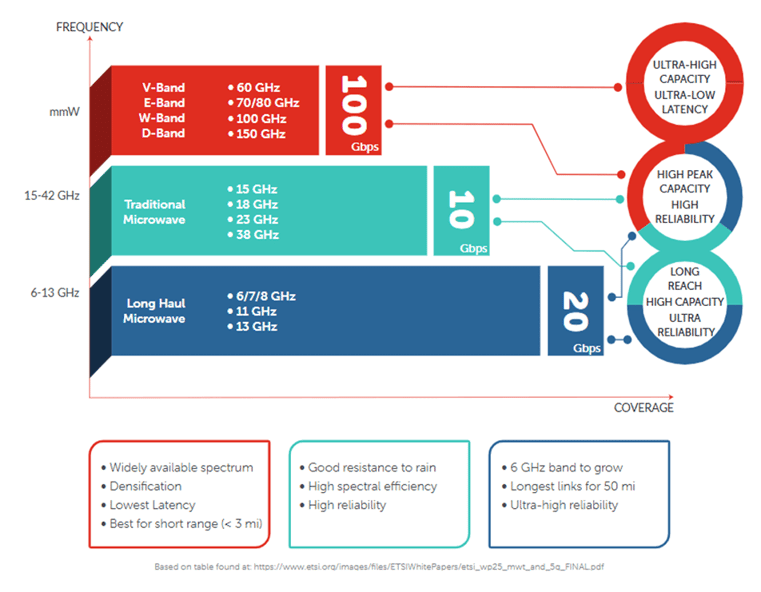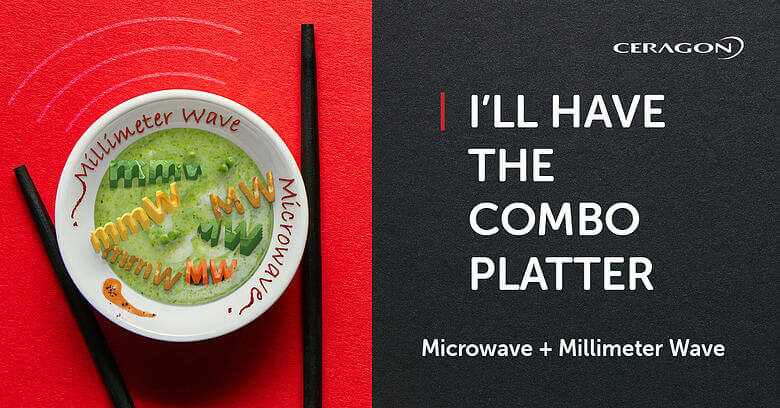Ever been in a restaurant and had trouble deciding on which dish to order? You have several choices – cost, ingredients, taste, nutrition, etc. Similarly, making technology choices for your network can be tough – to get the right combination of capabilities for best customer service, capacity requirements, distance, budget, latency, frequency use, and other options. This blog will break down two technology ‘ingredients’ that should be in any operator’s wireless hauling pantry – millimeter wave (mmW) and microwave (MW).
Operators are becoming more sophisticated in their operations. With the recent funding made available by government programs, operators are finding that they have more flexibility in their choice for technologies and network deployments. Building networks in more remote areas and in more challenging terrains has previously been financially unfeasible, but now there are new opportunities to make the business case work. Operators can expand their coverage and operations in the hopes of reaching rural and underserved communities with high-speed connectivity.
But having more options, can also add to confusion about which technologies to incorporate into the network. When to use Fiber? When to use Wireless? Which wireless solutions are best for which scenarios? How can different frequency bands affect options?
Having more tools in the toolbox can be helpful. And understanding how to leverage different technologies and frequency bands – both licensed and unlicensed – can make a huge difference in the efficiency, cost, and overall success of the network deployment.
FROM SOUP TO NUTS - ABOUT MILLIMETER-WAVE AND MICROWAVE
One of the first lessons that operators learn is that spectrum can be the biggest asset and tool available in their deployment plans. It is a limited resource. Therefore, it is vital that operators learn how to best leverage the spectrum available to them. Another lesson learned is the importance of backhaul – the network is only as fast and strong as its backbone. Just like in human anatomy... the spine is the most important structural support the body has. Compromise the spine, and the rest of the body falters.
Traditionally, microwave bands, in the 6-42 GHz range, have been used for backhauling and transport solutions. And these solutions still play a major role in operator deployments. Especially where and when Fiber is not a viable option. Wireless backhaul offers much faster time to market, more affordable deployment (requiring no digging and complicated right-of-way coordination), and extremely reliable, low-latency operation.
But microwave bands are getting more congested – especially as 5G proliferation increases. And, as licensed bands, there are fees for licenses involved. So, while microwave bands are still an important tool for operators, it is important that they consider adding other options as well. This is where millimeter wave opportunities, especially in the E-Band, become significant.

ABOUT E-BAND – HAVE YOUR CAKE AND EAT IT TOO
The E-band represents the frequency range from 60 GHz to 90 GHz and is characterized by very short wavelengths. One of the disadvantages of this frequency band is that atmospheric gasses and rain result in attenuation, hence it is primarily useful for shorter range signal transmission of not more than 5 km | 3 miles.
Due to the limited amount of spectrum available, most countries have freed up large chunks of bandwidth from 60 GHz to 86 GHz for ultra-high capacity backhaul, supporting fixed wireless and 5G services.
E-band is perfect for shorter distance, line-of-sight (LOS) deployments. It is also virtually interference free and enables high capacity, making it a perfect candidate in environments that require high bandwidth. Our E-band equipment has a small footprint with 1 or 2-foot dishes, enabling a very easy and quick deployment or mount.
Unlike fiber, which can be costly, slow, and highly disruptive, E-Band links can be deployed in hours, and moved and reused on different sites as network requirements evolve.
The need for 5G and high-capacity services is just as acute for municipal and business customers in a small town as it is in a big city. Carriers and WISPs are already utilizing the E-Band to deliver gigabit services to homes and businesses with success, and hundreds of smart cities have deployed E-Band networks for video surveillance, public Wi-Fi backhaul, municipal networks, and more.
THE COMBO PLATTER!
Now that we have done a dive into Microwave and E-Band, we can discuss the crème de la crème – combining two bands to gain the best of both worlds. Multiband aggregation, the combination of different frequency bands on the same radio link, leverages the E-Band high capacity with microwave availability and link range.
Ceragon’s multiband feature allows operators to combine E-band with microwave transmissions.
You may think that this endeavor will require additional shelter or rack space and two antennas on a pole – all costly considerations. But you’d be wrong. Ceragon offers a single antenna implementation that uses layer-1 carrier bonding. This means that no indoor unit, additional space, or additional antennas are needed. The result is lower operating costs by reducing the footprint, tower rental, licensing fees, and antenna procurement costs. Additionally, the single antenna solution simplifies the E-Band alignment which translates into additional savings on time and expenses.
THE SWEET SPOT
You can have it all, simultaneously - the high capacity of E-band and the high reliability of microwave, while optimizing capital investment and operating expenses.
WANT THE RECIPE FOR WIRELESS SUCCESS?
Download your complimentary ‘Combo Platter eBook’
*Interested in downloading the WISP version? Click here.


